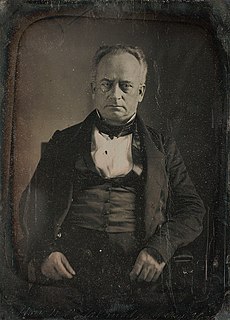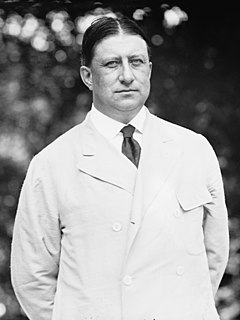
Martin Van Buren was an American lawyer and statesman who served as the 8th president of the United States from 1837 to 1841. A founder of the Democratic Party, he had previously served as the 9th governor of New York, the 10th United States secretary of state, and the 8th vice president of the United States. Later in his life, Van Buren emerged as an elder statesman and an important anti-slavery leader who led the Free Soil Party ticket in the 1848 presidential election.
The Anti-Masonic Party, also known as the Anti-Masonic Movement, was the earliest third party in the United States. Formally a single-issue party, it strongly opposed Freemasonry, but it later aspired to become a major party by expanding its platform to take positions on other issues. After emerging as a political force in the late 1820s, most of the Anti-Masonic Party's members joined the Whig Party in the 1830s and the party disappeared after 1838.

In politics and government, a spoils system is a practice in which a political party, after winning an election, gives government jobs to its supporters, friends (cronyism), and relatives (nepotism) as a reward for working toward victory, and as an incentive to keep working for the party—as opposed to a merit system, where offices are awarded on the basis of some measure of merit, independent of political activity.

William Learned Marcy was an American lawyer, politician, and judge who served as U.S. Senator, Governor of New York, U.S. Secretary of War and U.S. Secretary of State. In the latter office, he negotiated the Gadsden Purchase, the last major acquisition of land in the continental United States.

Silas Wright Jr. was an American attorney and Democratic politician. A member of the Albany Regency, he served as a member of the United States House of Representatives, New York State Comptroller, United States Senator, and Governor of New York.
The Barnburners and Hunkers were the names of two opposing factions of the New York state Democratic Party in the mid-19th century. The main issue dividing the two factions was that of slavery, with the Barnburners being the anti-slavery faction. While this division occurred within the context of New York politics, it reflected the national divisions in the United States in the years preceding the American Civil War.

Edward Thurlow Weed was a printer, New York newspaper publisher and Whig and Republican politician. He was the principal political advisor to prominent New York politician William H. Seward and was instrumental in the presidential nominations of William Henry Harrison (1840), Zachary Taylor (1848), and John C. Frémont (1856).

Horatio Seymour was an American politician. He served as Governor of New York from 1853 to 1854 and from 1863 to 1864. He was the Democratic Party nominee for president in the 1868 presidential election, won by Republican and General Ulysses S. Grant.

Historians and political scientists use Second Party System to periodize the political party system operating in the United States from about 1828 to 1852, after the First Party System ended. The system was characterized by rapidly rising levels of voter interest, beginning in 1828, as demonstrated by Election Day turnouts, rallies, partisan newspapers, and high degrees of personal loyalty to parties.

Nathaniel Pitcher Tallmadge was an American lawyer and politician. He served two terms as United States Senator from New York (1833–1844) and was the 3rd Governor of the Wisconsin Territory (1844–1845).

Azariah Cutting Flagg was an American newspaper printer and editor, and politician.
The Bucktails (1818–1826) were the faction of the Democratic-Republican Party in New York State opposed to Governor DeWitt Clinton. It was influenced by the Tammany Society. The name derives from a Tammany insignia, a deer's tail worn in the hat. The name was in use as early as 1791 when a bucktail worn on the headgear was adopted as the "official badge" of the Tammany Society. The wearing of the bucktail was said to have been suggested by its appearance in the costume of the Tammany Indians in the vicinity of New York.

John Van Buren was a United States lawyer, official and politician. In addition to serving as a key advisor to his father, President Martin Van Buren, he was also Attorney General of New York from 1845 to 1847.

The 1819/1820 United States Senate election in New York was held on February 2, 1819, and January 8, 1820, by the New York State Legislature to elect a U.S. Senator to represent the State of New York in the United States Senate.

The 1821 United States Senate election in New York was held on February 6, 1821, by the New York State Legislature to elect a U.S. Senator to represent the State of New York in the United States Senate.

The 1827 United States Senate election in New York was held on February 6, 1827, by the New York State Legislature to elect a U.S. Senator to represent the State of New York in the United States Senate.

Edwin Croswell, was an American journalist and politician. Croswell's father and uncle were both influential editors and journalists in the early 19th century. Edwin expanded the family's influence on American journalism.

The 60th New York State Legislature, consisting of the New York State Senate and the New York State Assembly, met from January 3 to May 16, 1837, during the fifth year of William L. Marcy's governorship, in Albany.

Solomon Southwick was an American newspaper publisher and political figure who was a principal organizer of the Anti-Masonic Party.

William Barnes Jr. was an American journalist and politician. The longtime owner and publisher of the Albany Evening Journal, Barnes was most notable as a major behind the scenes player in state and U.S. politics as a leader of New York's Republican Party.